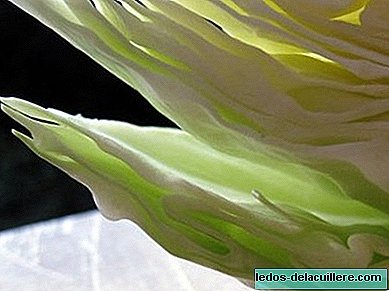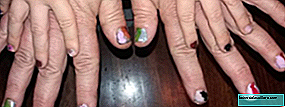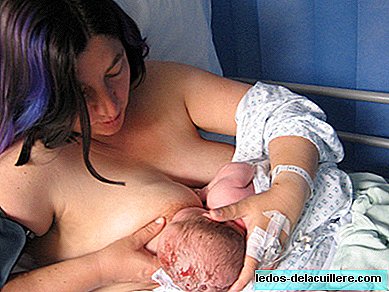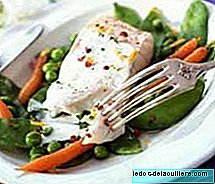
We finished our review of the vegetables in the infant feeding with another series of Vegetables that are recommended to be introduced after 12 months: cabbage or cabbage, asparagus and mushrooms.
The first two vegetables have a high nitrate content which, as we indicated in the previous entry, can be harmful for smaller babies. Although I would say that for asparagus there are other reasons to delay its introduction into the feeding of the baby, as we will see.
For all this, for the first baby porridge, after six months, it is best to introduce vegetables and vegetables with a tendency to accumulate less nitrates: zucchini, potatoes, peas, broccoli ...
As for mushrooms, although not grown in orchards, in nutrition edible mushrooms can be included in the group of vegetables. Examples of edible mushrooms are mushrooms, gurumelo, chanterelle, gallipierno or oronja.
There is very little information regarding mushrooms and other mushrooms for young children. And although most agree to introduce mushrooms from one year of age, I would say that it is not an especially difficult vegetable to digest. The best is consult our pediatrician to guide us in the vegetables that we have doubts.
Cabbage or cabbage in infant feeding
Cabbage or cabbage (Brassica oleracea var. Viridis), is an edible plant of the Brasicaceae family, native to the Mediterranean area, with very wide leaves, of which many varieties are known. Other varieties that grow with "flowers" and are suitable for babies from six months (provided they do not produce gas) are cauliflower and broccoli.
But common cabbage or green cabbage is typical green leafy vegetable that tends to accumulate nitratesThis is why it is not recommended for smaller babies.
As for its beneficial properties, cabbage is rich in vitamin A, E and C, nitrates, vitamins K, and U, β-carotene, in addition to having a high fiber content. Its main content is water (92%) and it has few calories and carbohydrates.
Regarding minerals, it is very rich in sulfur (which gives the characteristic smell of boiling them) and potassium, phosphorus, aluminum, calcium, fluorine, barium, magnesium, bromine.

Asparagus in infant feeding
Because of their tendency to accumulate nitrates, asparagus is also recommended after 12 months. However, there is not much information about the accumulation of such substances in asparagus, which makes me think that there may be other reasons to delay it in the baby's diet.
It is probably also due to the strong smell that the vegetable gives off and because some of the asparagus components are metabolized and excreted in the urine, giving it a distinctive slightly unpleasant smell caused by several degraded products that contain sulfur.
Asparagus (Asparagus officinalis) are young and tender stems of asparagus, a herbaceous plant of the Liliáceas family that reaches up to a meter and a half tall. Other vegetables such as onions and leeks also belong to this family (and we already mentioned that the onion is usually delayed precisely because of its strong aroma).
White asparagus is obtained by avoiding exposure of plants to light as they grow. Purple asparagus is different from green or white varieties, it is mainly characterized by a high sugar content and low fiber levels. From the wild asparagus (wild asparagus) the "asparagus tips" are used as food.
Among its beneficial properties are its high content of fiber, folates, beta-carotene or provitamin A, vitamin E and C, vitamins of group B and potassium, phosphorus, magnesium, calcium.
You can cook in many ways, combined with many foods, and even consume raw (fresh or preserved) the most tender sprouts. When giving it to the child for the first time we will do it separately and observing the tolerance to it.
Mushroom in infant feeding
Paris mushroom or common mushroom (Agaricus bisporus) is a species of fungus, widely cultivated for use in gastronomy. Its cultivation dates back to the 18th century in France (hence its popular name, "de Paris").
It is the most frequently used of edible mushroom species, lending itself to numerous forms of consumption.
The mushroom has a neutral and delicate flavor and has a low caloric content, around 20 calories per 100 grams. Its highest content is water (88%) and only contains 0.3% fat and does not contain cholesterol. It is relatively rich in dietary fiber, as well as in vitamin B6, vitamin C, vitamin D, potassium, selenium, phosphorus and niacin.
Its remineralizing effect is very useful in case of sick people or those who cannot take meat (they contain easily assimilable proteins). Its selenium content gives it an antioxidant effect.
All these properties make it a very soft vegetableI might say that it is suitable even for small babies, because they are easily digested. But not having found more information about mushrooms has made us delay until 12 months.
Because of its mild flavor, it is ideal for making fine sauces and accompanying other foods (rice, eggs, legumes ...), and children usually accept them quite well. You can cook boiled, steamed or grilled and add some iodized salt from 12 months.
It is not convenient to pick mushrooms or wild mushrooms unless we are true experts in recognizing edible species, which is quite difficult. We risk catching poisonous or toxic specimens by growing in inappropriate places. Better to consume the mushrooms that are marketed, and wash them well and cut the part with soil before cooking.
Remember to keep in mind that with any new food that we introduce for the first time in the diet of the little one we will have to be attentive to any reaction, as well as do it moderately, one at a time, and see if it tolerates it or not.
Cabbage or cabbage, asparagus and mushrooms will be part of a balanced diet for children and the whole family, in salads or dishes cooked in multiple ways, and always combining it with other foods that expand the sources of beneficial and necessary nutrients for development.












